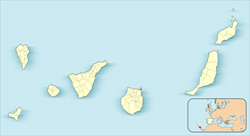Las Palmas de Gran Canaria in Las Palmas

Las Palmas is the easternmost of the two provinces that constitute the autonomous region of Canarias. It borders on the province of Santa Cruz de Tenerife to the west, and the Atlantic Ocean on all other sides.
Las Palmas consists of the islands of Gran Canaria, Fuerteventura, Lanzarote and La Graciosa as well as six small uninhabited islets. The province covers an area of 4,066km2 and has 1,120,406 inhabitants. Its highest point is Pico de las Nieves which reaches 1,956 m into the sky.
Like so many of the Spanish provinces, the province of Las Palmas was originally named after its capital. Since then, however, the capital has changed its name to Las Palmas de Gran Canaria. Las Palmas de Gran Canaria was founded in 1478 by Juan Rejón, a captain in the army of the Crown of Castile, when he started the campaign to include the archipelago in Spain under the Catholic Kings. It is Spain’s ninth most populated city with 379,925 inhabitants and situated in the north eastern corner of Gran Canaria.
 For the first many years the city’s only defence against pirates and other seafaring enemies was a small fortification situated in the mountains of the La Isleta peninsula, five kilometres away; however, towards the end of the 16th century, the increasing amount of attacks by buccaneers and foreign navies on the city led to the construction of several small fortifications in the city as well as a series of defence towers along the coastline.
For the first many years the city’s only defence against pirates and other seafaring enemies was a small fortification situated in the mountains of the La Isleta peninsula, five kilometres away; however, towards the end of the 16th century, the increasing amount of attacks by buccaneers and foreign navies on the city led to the construction of several small fortifications in the city as well as a series of defence towers along the coastline.
Only one of these towers has survived to the present day, the Torreón de San Pedro Mártir, constructed in 1577. In the same era city walls were constructed which enclosed the sides of the city from north to south, and parts of which still exist to the present day.
In the 19th century an event of vital importance for the city’s economy took place: the granting of a free port. This led to a great number of boats docking there and sowing the seed for what would eventually be the city and the province’s most important source of income: Tourism.
This early touristic interest led to the construction of the first hotel in Gran Canaria, the Hotel Santa Catalina which opened in 1890. It is still open today, and after extensive restoration in 2019 it was awarded the title of Europe’s Best Historic Luxury Hotel.
From being the most important tourist area on the island of Gran Canaria at the beginning of the tourist boom, the city today functions more like a metropolis and financial capital with shopping and services as its main raison d’être, and the touristic areas have moved to the south of the island.
However, one of its beaches, Las Canteras, at the north of the city, is considered one of the most outstanding urban beaches in Europe. Its 3.1 km of golden sands and a chalk reef that runs parallel along it at a distance of 200 metres offshore creating perpetually calm, warm waters, combine to make this a unique beach, and it receives hundreds of visitors all year round, keeping beach tourism kicking and alive in the city.


